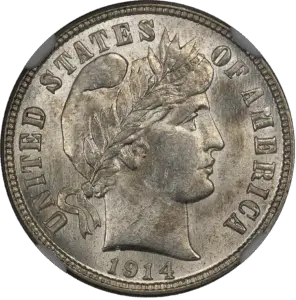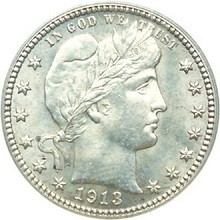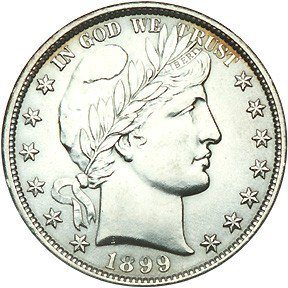Have you ever seen a nickel, dime, quarter, or half dollar from around the turn of the 20th century?
If you did, then you have seen some of the work of Charles Edward Barber — a noted coin designer.
Barber gained widespread recognition for his depictions of Liberty on many of the coins that were struck during that era.
Here’s more about Barber coins, Liberty Head nickels, and their values…
Barber Liberty Head Coins Explained
Barber is responsible for engraving, designing and co-creating a number of coins that include commemoratives and patterns.
However his most popular work is without doubt the Liberty Head nickels, dimes, quarters, and half dollars that were struck during the end of the 19th century and into the 20th century.
In fact, Barber is so popularly attached to these designs that most collectors tend to call these coins not by their “official” Liberty Head names — but, rather, these coins are usually called Barber coins.
If you take a look at most any coin book, coin price guide, or coin catalog, you will indeed find these dimes, quarters, and half dollars referenced sometimes exclusively as Barber coins. Sometimes “Liberty Head” takes a role as a parenthetical reference to these coins (though sometimes it is the “Barber” reference that is listed as secondary).
Interestingly, Barber’s nickel design is widely referred to as the Liberty nickel — not the Barber nickel. Although, it’s not very hard to come across some references to that 5-cent design with an honor to Barber’s name.
Liberty Head Nickels
 Liberty Head nickels were struck for regular circulation from 1883 to 1912 — though 5 examples of 1913 were produced and have sold at auction for over a million dollars.
Liberty Head nickels were struck for regular circulation from 1883 to 1912 — though 5 examples of 1913 were produced and have sold at auction for over a million dollars.
Two types of Liberty head nickels exist:
- There is the “no cents” variety that was struck in 1883; and
- And there is the “with cents” variety that was first struck in 1883 and lasted right to the very end of the design’s production in 1912.
Well-worn examples of common-date Liberty Head nickels can be bought for less than $2 or $3.
Some very rare Liberty Head nickels are worth more than $100 each. They include:
- 1885 Liberty Head nickel — $500+
- 1886 Liberty Head nickel — $250+
- 1912-S Liberty Head nickel — $125+
- 1913 Liberty Head nickel — $3 million+ (yes, 3 million dollars!)
Barber Coins
Barber dimes, quarters, and half dollars were first struck in 1892.
The last Barber half dollar was struck in 1915. Barber dimes and Barber quarters were minted until 1916.
Barber dimes, Barber quarters, and Barber half dollars saw no significant design variations during their time. However, lightly worn specimens of these coins have become quite scarce in recent years — as is especially the case with Barber half dollars.
Overall, Barber coins are very common, as are most dates. But many Barber coins (specifically, Barber quarters and half dollars) are increasingly scarce — for any date — in grades above Very Good to Fine.
- Well-worn, common-date Barber dimes and Barber quarters can be purchased for under $10 each.
- Well-worn, common-date Barber half dollars can easily be found for less than $25 each.
Some Barber dimes, quarters, and half dollars are very scarce in any condition. Let’s take a closer look at what some of these rare Barber coins are worth:
 Barber Dimes
Barber Dimes
- 1893 3 Over 2 Barber dime — $100+
- 1894-O Barber dime — $60+
- 1894-S Barber dime — $1.5 million+
- 1895 Barber dime — $75
- 1895-O Barber dime — $325+
- 1896-O Barber dime — $70+
- 1896-S Barber dime — $70+
- 1897-O Barber dime — $55+
- 1901-S Barber dime — $70+
- 1903-S Barber dime — $70+
- 1905-O Micro “O” Barber dime — $50+

Barber Quarters
- 1896-S Barber quarter — $800+
- 1897-S Barber quarter — $100+
- 1901-S Barber quarter — $3,900+
- 1913-S Barber quarter — $1,450+
- 1914-S Barber quarter — $100+
Barber Half Dollars
- 1892-O Micro “O” Barber half dollar — $2,200+
- 1893-S Barber half dollar — $120+
- 1896-S Barber half dollar — $100+
- 1897-O Barber half dollar — $135+
- 1897-S Barber half dollar — $125+
- 1913 Barber half dollar — $55+
- 1914 Barber half dollar — $120+
- 1915 Barber half dollar — $100+
Who Was Charles E. Barber?
Charles E. Barber became the 6th Chief Engraver of the United States Mint in 1879 after the passing of the 5th Chief Engraver — Charles’ father, William Barber.
Charles Barber built much recognition for himself because of the coins he designed during his tenure as Chief Engraver, a post he held until his death on February 18, 1917.
George T. Morgan, who is famous for designing the Liberty Head silver dollar (popularly called the “Morgan” dollar) took over as Chief Engraver after Charles E Barber’s death.
More About Barber Coins & Liberty Head Nickels
In addition to the links I’ve included above, here are some other great resources to help you learn more about Barber coins and Liberty Head nickels:





